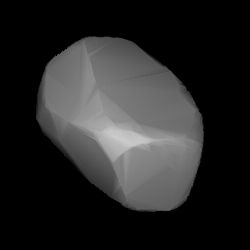1900 Katyusha
 Modelled shape of Katyusha from its lightcurve | |
| Discovery[1] | |
|---|---|
| Discovered by | T. Smirnova |
| Discovery site | Crimean Astrophysical Obs. |
| Discovery date | 16 December 1971 |
| Designations | |
| (1900) Katyusha | |
Named after | Yekaterina Zelenko (Soviet war pilot)[2] |
| 1971 YB · 1938 WM 1941 SS1 · 1950 LS 1953 GL1 · 1961 WD 1969 DC | |
| main-belt · Flora family[3] | |
| Orbital characteristics[1] | |
| Epoch 4 September 2017 (JD 2458000.5) | |
| Uncertainty parameter 0 | |
| Observation arc | 63.59 yr (23,226 days) |
| Aphelion | 2.5075 AU |
| Perihelion | 1.9116 AU |
| 2.2096 AU | |
| Eccentricity | 0.1348 |
| 3.28 yr (1,200 days) | |
| 354.20° | |
| 0° 18m 0.36s / day | |
| Inclination | 6.5426° |
| 281.91° | |
| 142.40° | |
| Physical characteristics | |
Mean diameter | 8.820±0.097 km[4] 9 km[5][6] |
| 9.4999 h (0.39583 d)[1] | |
| 0.29[5][6] 0.299±0.037[4] | |
| S[3] | |
| 12.2[1] | |
1900 Katyusha (prov. designation: 1971 YB) is a stony background asteroid from the inner asteroid belt, approximately 9 kilometers in diameter. It was discovered on 16 December 1971, by Russian astronomer Tamara Smirnova at the Crimean Astrophysical Observatory in Nauchnyj, on the Crimean peninsula[7] and named in honor of Yekaterina Zelenko, the only woman to credited with conducting an aerial ramming.[2]
Orbit and classification[edit]
Katyusha is a member of the Flora family, one of the largest groups of stony asteroids in the inner main-belt.[3] It orbits the Sun in the inner main-belt at a distance of 1.9–2.5 AU once every 3 years and 3 months (1,200 days). Its orbit has an eccentricity of 0.13 and an inclination of 7° with respect to the ecliptic.[1]
Naming[edit]
This minor planet was named in honor of Ukrainian Yekaterina Zelenko (1916–1941), a war pilot and Hero of the Soviet Union, known for being the only woman who had ever executed an aerial ramming. The asteroid's name "Katyusha" is a petname for Ekaterina.[2]
Physical characteristics[edit]
It rotates around its axis with a period of 9.4999 hours and with a brightness variation of 0.72 magnitude, indicating a non-spheroidal shape.[8]
According to the survey carried out by NASA's Wide-field Infrared Survey Explorer with its subsequent NEOWISE mission, Katyusha measures between 8.820 and 9 kilometers in diameter and its surface has an albedo between 0.29 and 0.299.[4][5][6] Katyusha has been characterized as a S-type asteroid.[3]
References[edit]
- ^ a b c d e "JPL Small-Body Database Browser: 1900 Katyusha (1971 YB)" (2016-11-15 last obs.). Jet Propulsion Laboratory. Archived from the original on 18 September 2020. Retrieved 14 June 2017.
- ^ a b c Schmadel, Lutz D. (2003). "(1900) Katyusha". Dictionary of Minor Planet Names – (1900) Katyusha. Springer Berlin Heidelberg. p. 152. doi:10.1007/978-3-540-29925-7_1901. ISBN 978-3-540-29925-7.
- ^ a b c d "LCDB Data for (1900) Katyusha". Asteroid Lightcurve Database (LCDB). Retrieved 23 August 2016.
- ^ a b c Masiero, Joseph R.; Grav, T.; Mainzer, A. K.; Nugent, C. R.; Bauer, J. M.; Stevenson, R.; et al. (August 2014). "Main-belt Asteroids with WISE/NEOWISE: Near-infrared Albedos". The Astrophysical Journal. 791 (2): 11. arXiv:1406.6645. Bibcode:2014ApJ...791..121M. doi:10.1088/0004-637X/791/2/121. Retrieved 14 June 2017.
- ^ a b c Masiero, Joseph R.; Mainzer, A. K.; Grav, T.; Bauer, J. M.; Cutri, R. M.; Nugent, C.; Cabrera, M. S. (November 2012). "Preliminary Analysis of WISE/NEOWISE 3-Band Cryogenic and Post-cryogenic Observations of Main Belt Asteroids". The Astrophysical Journal Letters. 759 (1): 5. arXiv:1209.5794. Bibcode:2012ApJ...759L...8M. doi:10.1088/2041-8205/759/1/L8. Retrieved 23 August 2016.
- ^ a b c Mainzer, A.; Grav, T.; Masiero, J.; Hand, E.; Bauer, J.; Tholen, D.; et al. (November 2011). "NEOWISE Studies of Spectrophotometrically Classified Asteroids: Preliminary Results". The Astrophysical Journal. 741 (2): 25. arXiv:1109.6407. Bibcode:2011ApJ...741...90M. doi:10.1088/0004-637X/741/2/90. Retrieved 23 August 2016.
- ^ "1900 Katyusha (1971 YB)". Minor Planet Center. Retrieved 23 August 2016.
- ^ Sada, Pedro V. (September 2008). "CCD Photometry of Six Asteroids from the Universidad de Monterry Observatory" (PDF). Minor Planet Bulletin. 35 (3): 105–107. Bibcode:2008MPBu...35..105S. ISSN 1052-8091. Retrieved 17 March 2020.
External links[edit]
- Asteroid Lightcurve Database (LCDB), query form (info Archived 16 December 2017 at the Wayback Machine)
- Dictionary of Minor Planet Names, Google books
- Asteroids and comets rotation curves, CdR – Observatoire de Genève, Raoul Behrend
- Discovery Circumstances: Numbered Minor Planets (1)-(5000) – Minor Planet Center
- 1900 Katyusha at AstDyS-2, Asteroids—Dynamic Site
- 1900 Katyusha at the JPL Small-Body Database
